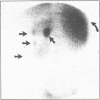Abstract
Ninety patients whose spleen had been removed either because of trauma (41 cases) or as an elective procedure (49) were investigated for return of splenic function by counting pitted red cells and examining spleen scans made after injection of heat damaged 99mTc labelled red cells. There was no significant difference in the proportion of pitted red cells between the two groups of patients. Evidence of splenic tissue in scintiscans was not invariably associated with low pitted red cell values, suggesting that the presence of splenic tissue did not necessarily mean return of splenic function. In every patient whose proportion of pitted red cells was less than 16.2% the scintiscan showed splenic uptake. The proportion of patients with pitted red cell values below 16.2% was significantly higher in the group operated on for trauma, and it is concluded that this was due to splenosis. A high inverse correlation between pitted red cell counts and computed splenic volumes was found. Patients with pitted red cell values of less than 16.2% had computed volumes of 22-133 cm3; below this range the proportion of pitted red cells rose very sharply. These results confirm that splenosis occurs in adults, though less often than in children, and suggest that when splenic tissue is to be implanted a graft of at least 20-30 cm3 is needed to ensure satisfactory return of splenic function.
Full text
PDF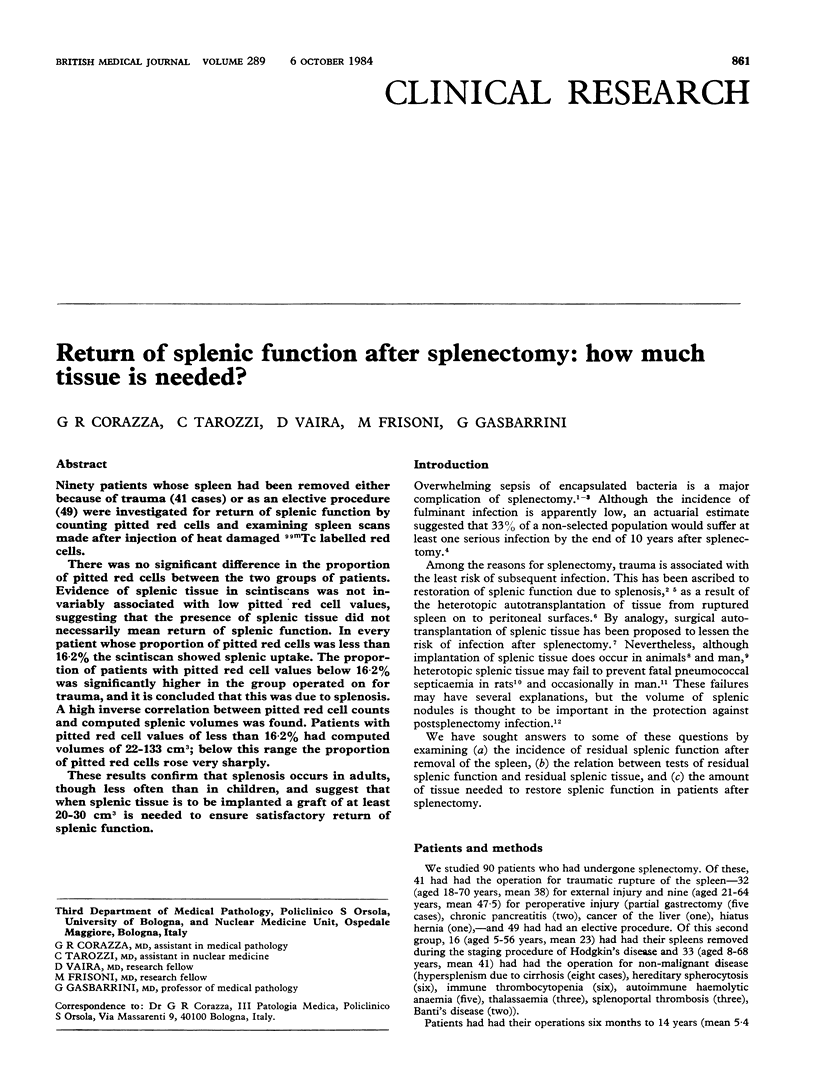
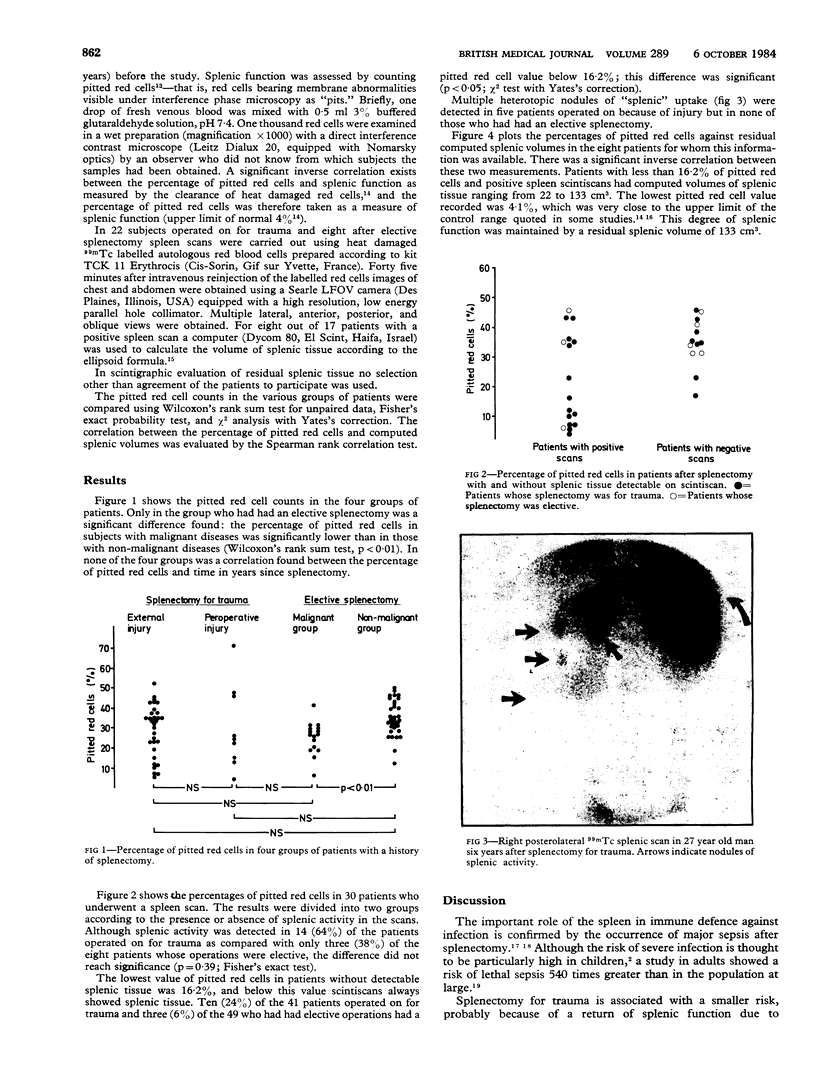
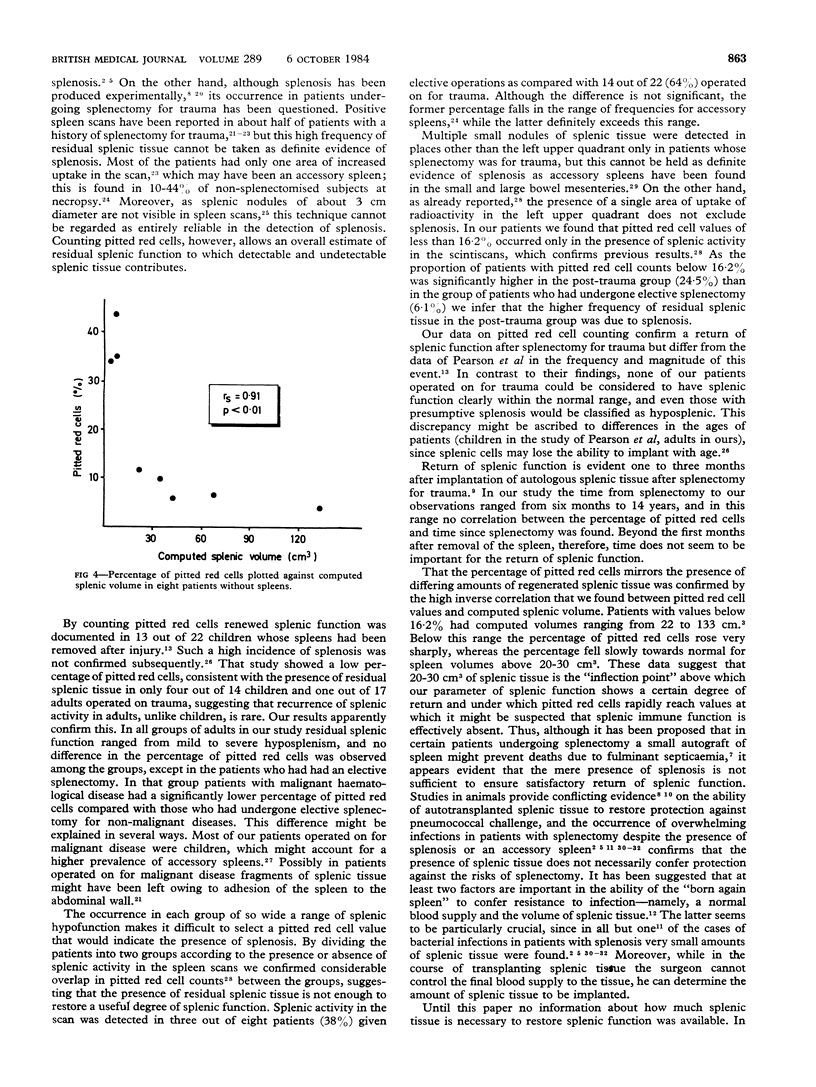
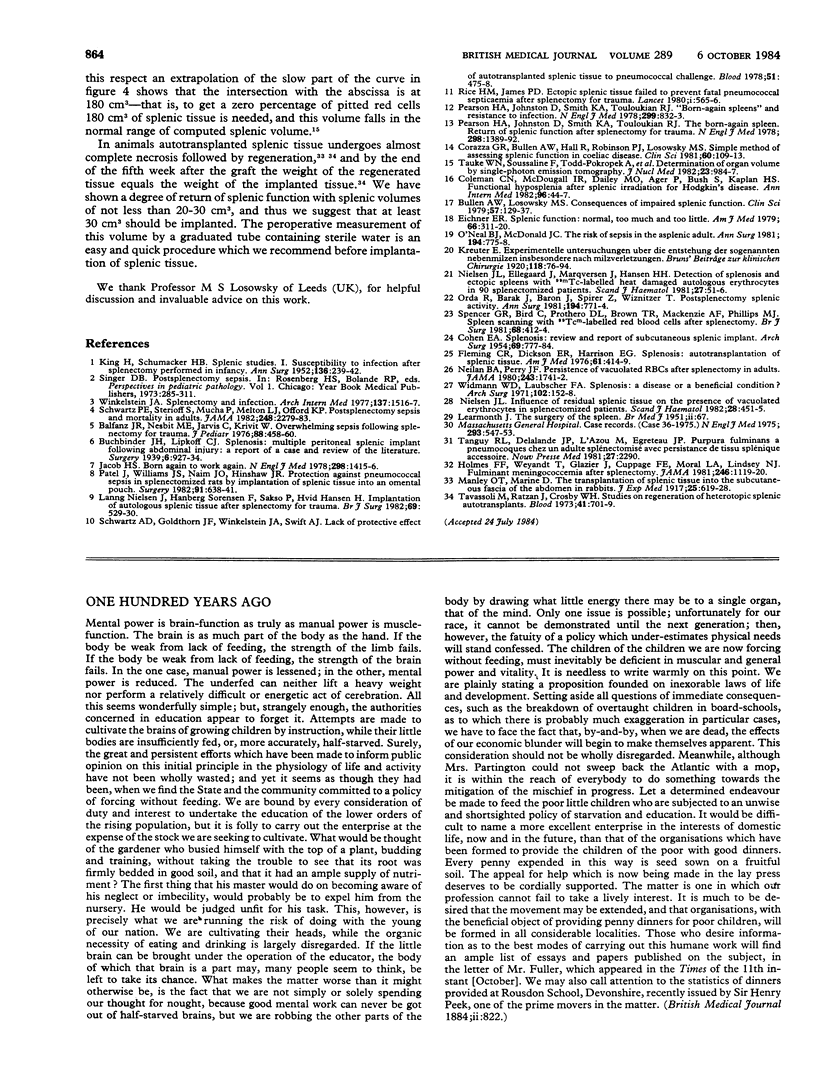
Images in this article
Selected References
These references are in PubMed. This may not be the complete list of references from this article.
- Balfanz J. R., Nesbit M. E., Jr, Jarvis C., Krivit W. Overwhelming sepsis following splenectomy for trauma. J Pediatr. 1976 Mar;88(3):458–460. doi: 10.1016/s0022-3476(76)80267-3. [DOI] [PubMed] [Google Scholar]
- Bullen A. W., Losowsky M. S. Consequences of impaired splenic function. Clin Sci (Lond) 1979 Aug;57(2):129–137. doi: 10.1042/cs0570129. [DOI] [PubMed] [Google Scholar]
- COHEN E. A. Splenosis; review and report of subcutaneous splenic implant. AMA Arch Surg. 1954 Dec;69(6):777–784. [PubMed] [Google Scholar]
- Coleman C. N., McDougall I. R., Dailey M. O., Ager P., Bush S., Kaplan H. S. Functional hyposplenia after splenic irradiation for Hodgkin's disease. Ann Intern Med. 1982 Jan;96(1):44–47. doi: 10.7326/0003-4819-96-1-44. [DOI] [PubMed] [Google Scholar]
- Corazza G. R., Bullen A. W., Hall R., Robinson P. J., Losowsky M. S. Simple method of assessing splenic function in coeliac disease. Clin Sci (Lond) 1981 Jan;60(1):109–113. doi: 10.1042/cs0600109. [DOI] [PubMed] [Google Scholar]
- Eichner E. R. Splenic function: normal, too much and too little. Am J Med. 1979 Feb;66(2):311–320. doi: 10.1016/0002-9343(79)90554-0. [DOI] [PubMed] [Google Scholar]
- Fleming C. R., Dickson E. R., Harrison E. G., Jr Splenosis: autotransplantation of splenic tissue. Am J Med. 1976 Sep;61(3):414–419. doi: 10.1016/0002-9343(76)90380-6. [DOI] [PubMed] [Google Scholar]
- Holmes F. F., Weyandt T., Glazier J., Cuppage F. E., Moral L. A., Lindsey N. J. Fulminant Meningococcemia after splenectomy. JAMA. 1981 Sep 4;246(10):1119–1120. [PubMed] [Google Scholar]
- Jacob H. S. Born again to work again. N Engl J Med. 1978 Jun 22;298(25):1415–1416. doi: 10.1056/NEJM197806222982509. [DOI] [PubMed] [Google Scholar]
- KING H., SHUMACKER H. B., Jr Splenic studies. I. Susceptibility to infection after splenectomy performed in infancy. Ann Surg. 1952 Aug;136(2):239–242. doi: 10.1097/00000658-195208000-00006. [DOI] [PMC free article] [PubMed] [Google Scholar]
- LEARMONTH J. The surgery of the spleen. Br Med J. 1951 Jul 14;2(4723):67–76. doi: 10.1136/bmj.2.4723.67. [DOI] [PMC free article] [PubMed] [Google Scholar]
- Lanng Nielsen J., Sørensen F. H., Saksø P., Hansen H. H. Implantation of autologous splenic tissue after splenectomy for trauma. Br J Surg. 1982 Sep;69(9):529–530. doi: 10.1002/bjs.1800690911. [DOI] [PubMed] [Google Scholar]
- Neilan B. A., Perry J. F., Jr Persistence of vacuolated RBCs after splenectomy in adults. JAMA. 1980 May 2;243(17):1741–1742. [PubMed] [Google Scholar]
- Nielsen J. L., Ellegaard J., Marqversen J., Hansen H. H. Detection of splenosis and ectopic spleens with 99mTc-labelled heat damaged autologous erythrocytes in 90 splenectomized patients. Scand J Haematol. 1981 Jul;27(1):51–56. doi: 10.1111/j.1600-0609.1981.tb00451.x. [DOI] [PubMed] [Google Scholar]
- Nielsen J. L. Influence of residual splenic tissue on the presence of vacuolated erythrocytes in splenectomized patients. Scand J Haematol. 1982 May;28(5):451–455. doi: 10.1111/j.1600-0609.1982.tb00551.x. [DOI] [PubMed] [Google Scholar]
- O'Neal B. J., McDonald J. C. The risk of sepsis in the asplenic adult. Ann Surg. 1981 Dec;194(6):775–778. doi: 10.1097/00000658-198112000-00020. [DOI] [PMC free article] [PubMed] [Google Scholar]
- Orda R., Barak J., Baron J., Spirer Z., Wiznitzer T. Postsplenectomy splenic activity. Ann Surg. 1981 Dec;194(6):771–774. doi: 10.1097/00000658-198112000-00019. [DOI] [PMC free article] [PubMed] [Google Scholar]
- Patel J., Williams J. S., Naim J. O., Hinshaw J. R. Protection against pneumococcal sepsis in splenectomized rats by implantation of splenic tissue into an omental pouch. Surgery. 1982 Jun;91(6):638–641. [PubMed] [Google Scholar]
- Pearson H. A., Johnston D., Smith K. A., Touloukian R. J. The born-again spleen. Return of splenic function after splenectomy for trauma. N Engl J Med. 1978 Jun 22;298(25):1389–1392. doi: 10.1056/NEJM197806222982504. [DOI] [PubMed] [Google Scholar]
- Rice H. M., James P. D. Ectopic splenic tissue failed to prevent fatal pneumococcal septicaemia after splenectomy for trauma. Lancet. 1980 Mar 15;1(8168 Pt 1):565–566. doi: 10.1016/s0140-6736(80)91056-9. [DOI] [PubMed] [Google Scholar]
- Schwartz A. D., Goldthorn J. F. "Born-again spleens" and resistance to infection. N Engl J Med. 1978 Oct 12;299(15):832–833. doi: 10.1056/NEJM197810122991512. [DOI] [PubMed] [Google Scholar]
- Schwartz A. D., Goldthorn J. F., Winkelstein J. A., Swift A. J. Lack of protective effect of autotransplanted splenic tissue to pneumococcal challenge. Blood. 1978 Mar;51(3):475–478. [PubMed] [Google Scholar]
- Schwartz P. E., Sterioff S., Mucha P., Melton L. J., 3rd, Offord K. P. Postsplenectomy sepsis and mortality in adults. JAMA. 1982 Nov 12;248(18):2279–2283. [PubMed] [Google Scholar]
- Spencer G. R., Bird C., Prothero D. L., Brown T. R., Mackenzie F. A., Phillips M. J. Spleen scanning with 99Tcm-labelled red blood cells after splenectomy. Br J Surg. 1981 Jun;68(6):412–414. doi: 10.1002/bjs.1800680616. [DOI] [PubMed] [Google Scholar]
- Tanguy R. L., Delalande J. P., L'Azou M., Egreteau J. P. Purpura fulminans à pneumocoques chez un adulte splénectomisé avec persistance de tissu splénique accessoire. Nouv Presse Med. 1981 Jun 20;10(27):2290–2290. [PubMed] [Google Scholar]
- Tauxe W. N., Soussaline F., Todd-Pokropek A., Cao A., Collard P., Richard S., Raynaud C., Itti R. Determination of organ volume by single-photon emission tomography. J Nucl Med. 1982 Nov;23(11):984–987. [PubMed] [Google Scholar]
- Tavassoli M., Ratzan R. J., Crosby W. H. Studies on regeneration of heterotopic splenic autotransplants. Blood. 1973 May;41(5):701–709. [PubMed] [Google Scholar]
- Widmann W. D., Laubscher F. A. Splenosis. A disease or a beneficial condition? Arch Surg. 1971 Feb;102(2):152–158. doi: 10.1001/archsurg.1971.01350020062018. [DOI] [PubMed] [Google Scholar]
- Winkelstein J. A. Splenectomy and infection. Arch Intern Med. 1977 Nov;137(11):1516–1517. [PubMed] [Google Scholar]



